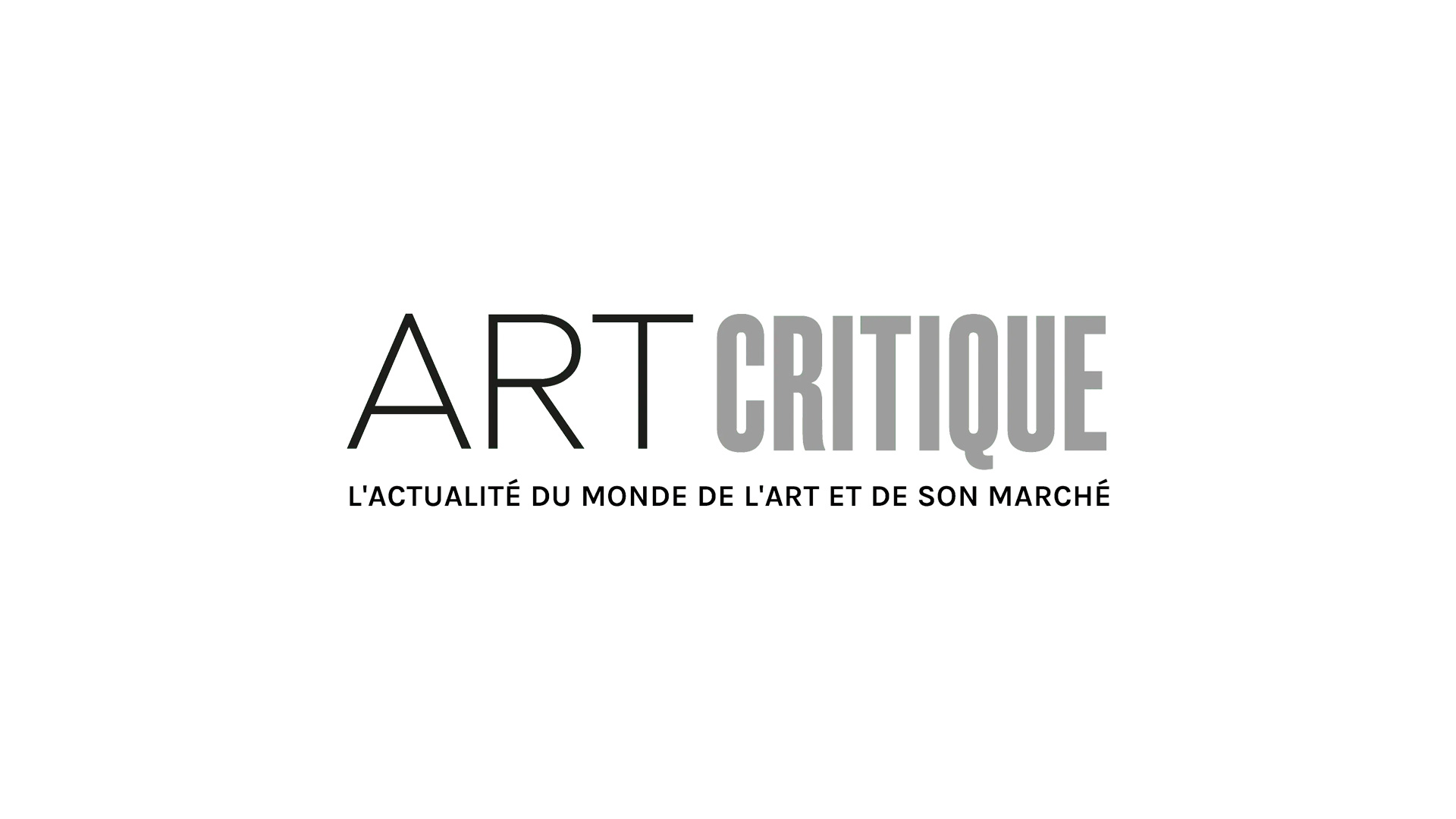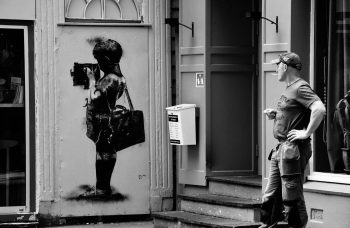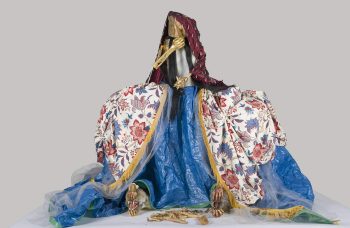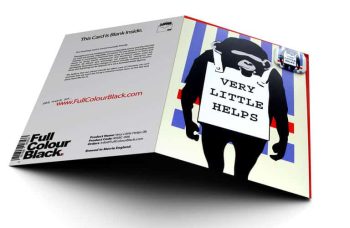For artist David Breuer-Weil, art and art making became what he described as a “lifesaver” during the onset of the pandemic and the months that have followed. Breuer-Weil, who is based in London and well-known for his “Project” installations and large-scale bronze sculptures, has released a new book that compiles some of the work that he’s created during the pandemic. Fittingly titled Golden Drawings, the book showcases a series of work that are somewhat different to his oeuvre but offer a stunning reflection on life during the pandemic.
On the 20th of March last year, just days after the whole of the UK was plunged into what would be its first national lockdown, Breuer-Weil began to experience COVID-19 symptoms. For the next six days, as his symptoms worsened, he began a series of drawings embellished with gold leaf that became like a buoy. Thankfully, Breuer-Weil recovered from the virus, but he continued the series of drawings for weeks as the pandemic and lockdown continued, making 66 drawings in total.
Dubbed the “Golden Drawings,” Breuer-Weil brought them together to create his newest book by the same name. Alongside each of the 66 drawings, which are on view in an online exhibition through June, Breuer-Weil recorded his thoughts which accompany his drawings offering incite and context for the works.
If I’m honest, when I cracked Golden Drawings open, I was a bit hesitant; if 2020 taught us anything, it was to be cautious, right? If I was nervous that the book might offer too lofty a perspective on the state of the world or that I might leave its pages feeling forlorn as the UK perseveres through its third national lockdown, I wouldn’t have been more wrong.
Golden Drawings, while rooted in Breuer-Weil’s personal and intimate experience with the pandemic, offers a sense of connectedness in a time when physically connecting has become difficult if not impossible. The drawings are a beautiful interpretation of the artist’s walk through the early months of the pandemic. Meanwhile, the juxtaposition of graphite against gold leaf is stunning and each time you look at one of the drawings, there’s something new that catches your eye.
All 66 of the drawings are beautifully complimented with excerpts of Breuer-Weil’s thoughts, that read much like a running journal entry. Golden Drawings is somewhat of a narration of the lived experience of the pandemic.
This is the first time that the artist has written his own accompanying text, his words are relatable, thought-provoking, and comforting. Therapeutic undertones run through Breuer-Weil’s drawings and writings, connecting artwork after artwork, page after page. I found it impossible not to let those threads run out of the book and into my own experiences.
I sat down, planning to start the book and just a few hours later, I was turning the last page; I couldn’t put the book down. What struck me about Golden Drawings was how refreshing it was in being immersed in another’s pandemic experience and realising the commonalities we shared. Breuer-Weil’s drawings became an opportunity to meditate on the past year in a way I’ve yet to do.
Recently, I had the wonderful opportunity to chat about Golden Drawings with Breuer-Weil on the phone. Today, we’re sharing that interview with you:
Katherine Keener: Your drawings and writings feel cathartic. Was publishing them together as a book kind of the culmination of that experience?
David Breuer-Weil: Normally, when I’ve created books before, I have an art critic or a scholar write the introduction to the book. But in this case, the words came as I was drawing and so it was a decision to put my own words with the drawings, which I like as an idea. There’s a tradition of doing that in the past with people like William Black, who published poems with pictures at the same time. It’s not done that often these days, but I think it could be quite a nice genre, that thing of words with pictures.
KK: I do agree, your writings offered context and incite without pigeonholing the drawings or even what the viewer or reader was meant to experience. You touched briefly on your process, but how did you choose your subjects? Did your drawings come first, dictating your writing?
DBW: I would say that the drawings are primary, because that’s my primary expression. I don’t really consider myself a writer, although I have written quite a lot. So, I tried to make the writings as natural, heartfelt, and simple as possible. And people did actually respond to it well as writing, which was quite interesting, so I think that’s a question of just being modest and natural about it.
KK: The first six “Golden Drawings” were created quite quickly, one each day while you were sick. After that, you can see by the dates found on the drawings that some took a day while others were completed over a few days. Was that simply the natural progression of the series? Or, as time went on, were they requiring more preparation?
DBW: I think in the first few drawings, I’m discovering a new medium, because I hadn’t really used much gold before. Actually, I resisted using it because it’s too decorative. But I found the gold was quite uncanny; it added a level of unreality and allowed a look into a different world. The gold brings a different psychological dimension. With the first drawings, I didn’t know what to expect. I was exploring. Then as time goes on, as I’m using the medium more and technically becoming more familiar with it, I’m using it to express more and expanding outwards. In fact, since Golden Drawings was published, I’ve been working on a new, very ambitious piece, which is large scale drawings in many parts kind of based on the Bayeux Tapestry. So, the early “Golden Drawings” are about finding a new medium and running with it.
KK: I was going to ask you about your use of gold leaf, because you do describe it in the introduction to your book as “too decorative,” which you’ve echoed. Why were you drawn to such a flashy medium during a pandemic and a year that most would probably describe as having been bleak? It could feel like an odd juxtaposition to have this beautiful, bright gold leaf set against what many might describe as a desolate year?
DBW: I think there are a few reasons for this. The first is just a feeling you have when you make art and it feels right. So, the feel of it is number one and I felt that quite strongly. The second reason is that years ago, I worked with and studied a lot of medieval manuscripts. Many of those are illuminated with gold leaf and a lot of them were actually from quite early in the 14th century, which was the age of the Black Death. A lot of the manuscripts reference that and have this gold leaf. So, I’m making a deliberate connection between the pandemic now and older pandemics, where the reaction was often, artistically, a kind of apocalyptic imagery in connection with this kind of gold background. But the third reason is that during the first lockdown, there was, for England, quite unprecedentedly wonderful weather. We had this glorious sunshine every day. So, there was all this weird stuff going on and at the same time nature was out in all its glory. I wanted to express that paradox of while the world’s going through this terrible thing, the weather, at least in England, was marvellous, which is not typical for the country. So, the choice to use gold leaf was a combination of those three factors.
KK: From Drawing One to Drawing Sixty-Six, there seems to be an evolution that has taken place. The first drawings feel as though there is an urgency to create them and get them down on paper, but as you progress through the drawings, they take on a much more reflective nature. This is emphasized by your writings, which towards the end of the book are hugely introspective and meditate on current life, the past, and the future. Do you feel as though you’re the later Golden Drawings are reacting not only to the pandemic but to the issues that society is facing that began to come to the surface after the pandemic took the spotlight for a while?
DBW: I definitely think that’s correct to say. The pandemic is one thing, but there are a lot of other things going on in the world that were very important and powerful and I think that art, at least for me, needs to reflect the moment you’re living in. I think there is a lot of art that has become preoccupied with the art market and money, which is not really what it’s about in the long-term, in my opinion. In 100 years, or 200 years, when people look back at this time, they are going to want something that expresses what was happening. Much like those medieval works, which reflected their times.
KK: How do you think this series and the pandemic have affected your work as an artist?
DBW: I think there are a lot of images that have come from the pandemic, the cover of the book [Drawing Forty Five], which depicts the clapping hands is a good example of that. You have this tragic image from the pandemic, but it’s also unbelievably positive when we came out every Thursday night clapping for the NHS. Sometimes the worst times bring out the best in humanity. That’s the kind of paradox that is really quite interesting and is expressed in the art. So, I think that you get these marvellous things about humanity in bad times and the art is this marvellous thing that stays there after the bad times. It’s taking something positive, out of all of the negative, which does happen with art quite a lot.
KK: You’ve mentioned these drawings being documentation for future generations can look back to. What has struck me is the accessibility of these drawings and your writings. Even if someone has no background in art, you can empathise with and connect to Golden Drawings…
DBW: I think one of the things to come out of the pandemic is that the whole world is in this together. Different kinds of elitism have been broken down and one of those is art, where for a long time, art was catering to a small group of people who are, in a way, art world insiders. I think it’s important to reclaim art as a tool and as a language for the whole world.
Towards the end of our conversation, Breuer-Weil added that the drawings sparked another series of large-scale oil paintings that took up much of his time during the second lockdown and found inspiration in the Duveen Galleries at Tate Britain. So, while the “Golden Drawings” are works in their own right, they became studies for Breuer-Weil’s larger piece.
Perhaps that is symbolic of the pandemic. The trauma, loss, frustration, and joy in the things we once took for granted, all of these things and more have made up a complete period, that has reshaped the world. The pandemic has been an unexpected period of upheaval but, it’s also a period that will play a role in society as we move forward, and perhaps it will prove to be preparatory for a better future. A future where we find the glint of gold in all that surrounds us.











